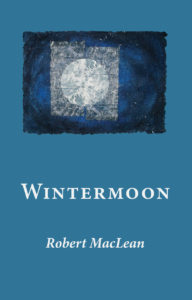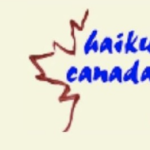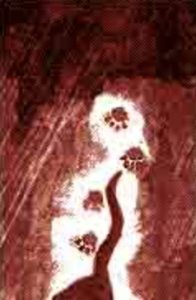 In Wintermoon Robert MacLean distils twenty-five years of living in Kyoto, Japan, into a single seasonal cycle seen through the radically minimalist lens of haiku. Here are 119 precise instants of focus, divided into eleven sequences – ‘stepping stones / leading to / a waterfall’. Each set of poems arrives at an awareness different from the one with which the set began, and the book as a whole maps a transformative journey filled with Zen practice, loneliness, university teaching, questionings, cultural acclimation, intimate encounters with nature, romance and marriage, and the death of parents and of an unborn child. Each sequence is a record of a series of acute and vital perceptions of the world.
In Wintermoon Robert MacLean distils twenty-five years of living in Kyoto, Japan, into a single seasonal cycle seen through the radically minimalist lens of haiku. Here are 119 precise instants of focus, divided into eleven sequences – ‘stepping stones / leading to / a waterfall’. Each set of poems arrives at an awareness different from the one with which the set began, and the book as a whole maps a transformative journey filled with Zen practice, loneliness, university teaching, questionings, cultural acclimation, intimate encounters with nature, romance and marriage, and the death of parents and of an unborn child. Each sequence is a record of a series of acute and vital perceptions of the world.
[Cover image: Tsuki (Moon) by Sarah Brayer: sarahbrayer.com]
Robert MacLean’s haiku are to the haiku of Bashō and Buson as Rilke’s sonnets are to the sonnets of Petrarch and Leopardi. They step back and forth across the rules (which don’t work in the English language anyway) but adhere with grace and vigor to the principles. Principles aren’t rules; they’re something better: insights, visions, even, at the best of times, enlightened realizations. – Robert Bringhurst
Beautifully laid out, and at times tremendously moving, the haiku in Wintermoon are allowed to breathe in a way that matches the practice of meditation that is one of its themes. Ranging from classic, Zen-like simplicity to bold, surrealistic imagery, but with a light touch throughout, they consistently sound a ‘harmonic / of a deeper tuning’. – Philip Rowland
Just a breath of words. But when I look, they disappear into the ink, taking me with them. Note to readers : keep fireflies in pocket. – Red Pine
Billy Mills in his Recent Reading series (June 2022 Part 2) says of Robert MacLean’s Wintermoon: ‘It is the penultimate sequence, ‘January’ that is the most poignant of all. This set of eight haiku circles round the premature death of a son .… There’s an inevitable comparison with Issa’s great poems on the deaths of his children, but it’s to MacLean’s great credit that his poems more than hold their own.’ Click here to read the whole review (you’ll need to scroll down a little).
Ian Brinton has reviewed Wintermoon in The Long Poem Magazine: ‘The title … is taken from a haiku by the eighteenth-century Japanese poet and painter Yosa Buson ‘winter moon / pebbles / beneath my shoe’ and the pebbles in MacLean’s sequence, like Snyder’s rocks [in ‘Riprap’], are placed as stepping stones along an individual pathway … the one “less travelled by”…’. Click here to read the whole review.
There’s a nice short review of Wintermoon in Modern Haiku by Paul Miller, the journal’s editor. (Click here: you’ll need to scroll down a bit to get to it: the ‘Briefly Reviewed’ section is quite long.) The review ends:
 Jennifer Harrison has published a long and perceptive review of Wintermoon in Haiku Canada: ‘This new collection of sparse, astute poems distils more than twenty-five years of Robert MacLean’s thinking about what is essential in poetry.… MacLean’s mastery and innovative understanding of the haiku lens are immediately evident: one or two poems per page, simplicity of diction, each poem moving elegantly across the page, belying the intense contemplation of its conveyance through a language that is precise with unsaid evocation.… a voice on paper that responds to the … challenge [of] how to understand the simplicity of a landscape’s shapes and elemental rhythms, [and] how to carve away language from tradition to arrive at the meaning of such words as journey, breath and hearth. Click here to read the whole review.
Jennifer Harrison has published a long and perceptive review of Wintermoon in Haiku Canada: ‘This new collection of sparse, astute poems distils more than twenty-five years of Robert MacLean’s thinking about what is essential in poetry.… MacLean’s mastery and innovative understanding of the haiku lens are immediately evident: one or two poems per page, simplicity of diction, each poem moving elegantly across the page, belying the intense contemplation of its conveyance through a language that is precise with unsaid evocation.… a voice on paper that responds to the … challenge [of] how to understand the simplicity of a landscape’s shapes and elemental rhythms, [and] how to carve away language from tradition to arrive at the meaning of such words as journey, breath and hearth. Click here to read the whole review.
Judy Kendall, editor of the haiku magazine Presence, has written a review of Robert Maclean’s Wintermoon. Here’s what she says about Robert’s work:
‘MacLean writes well and from the heart. Forewarned that he was a Blake expert, I scrutinized the book for echoes, or images, of Blake. I found mainly silence and space. These too of course are present in Blake. However, in Wintermoon they are the silences and spaces of Japan, for, as the back cover rightly proclaims, this book distils twenty five years of living in Kyoto. An ex-expatriate myself, I find much of it so authentic. It resonates, bringing back my own memories of the smells, sounds, vistas and idiosyncrasies of Japan. It’s there in the title of the third section, ‘Three-Mat Room’, and in the detail of
5 a.m. / old ladies gossiping / by blue garbage bags
erase the whiteboard / turn off the light / bow to the empty room
‘On the other hand, Wintermoon has a stronger zen influence than the colour of my own memories, an influence that to some extent also structures the book.
‘I admire the brevity and sparse minimalism of the best of these Wintermoon haiku. It is evident in the unmistakable Issa influence – with snake, snail and cockroach haiku. It’s also there in the almost unbearable, beautiful yet heart-wrenching penultimate section “January” which you will have to read for yourself because I am not going to do it the injustice of quoting from it here. Instead, I offer you these delights,
even though they seemed /to be listening / how quickly everyone leaves
packed tight / on hillsides / the dead
‘Superb strong stuff – a poet to watch.’
Click here to visit the Presence website.
March 2022, 84 pages, 5.5 x 8.5 in / 140 x 210 mm, ISBN 978-4-907359-39-3
Click here to read an extract from this book.
Click here to buy from Amazon in Japan, click here to buy from Amazon in the UK, click here to buy from Amazon in the US.

